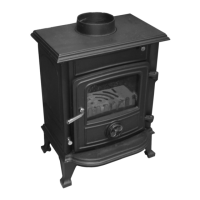13
Parts & Service: 020 8988 7400 / E-mail: Parts@clarkeinternational.com or Service@clarkeinternational.com
.
CONNECTION TO THE CHIMNEY
This MUST be carried out by an accredited/competent person and/or
approved by your local Building Control Officer before using the stove.
Any existing flue must be in good condition with suitable access for collection
and removal of debris. Details of suitable linings for use with solid fuel are given
in the Official HETAS guide that can be viewed on their website at
www.hetas.co.uk
It is also important that suitable flue pipe complying with Building Regulations is
used to connect the stove to the chimney flue and that suitable access is
provided into the flue for regular inspection and sweeping of the flueways.
Chimneys should be as straight as possible. Horizontal runs should be avoided
and the horizontal section should never exceed 150mm (6 inches) in length.
Flue connections must be well sealed.
With a vertical rear flue the chimney may be swept through the stove. If it is
not possible to pass the sweeps brush through the stove, a soot door will be
necessary. This may be either in the actual brickwork of the chimney or fitted
in the register plate. Suitable positions of soot doors are shown in Figures 6-7.
Stove Air Supplies
Stove with flue draught
stabiliser
Permanently open vents as below:
If design air permeability>5.0m
3
/(h.m
2
) then
300mm
2
/kW for first 5kW of appliance rated
output
850mm
2
/kW for balance of appliance rated
output
If design air permeability<5.0m3/(h.m
2
) then 850
mm
2
/kW for balance of appliance rated output
Stove with no flue draught
stabiliser
Permanently open vents as below:
If design air permeability>5.0m3/(h.m2) then 550
mm
2
/kW of appliance rated output above 5kW
If design air permeability<5.0m
3
/(h.m
2
) then 550
mm
2
/kW for balance of appliance rated output

